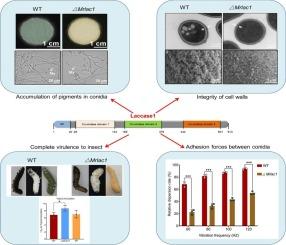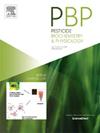Mrlac1, an extracellular laccase, is required for conidial morphogenesis as well as the well adaptability in field of Metarhizium rileyi
IF 4.2
1区 农林科学
Q2 BIOCHEMISTRY & MOLECULAR BIOLOGY
引用次数: 0
Abstract
Acting as an extremely promising fungal pesticide, Metarhizium rileyi exhibits robust insecticidal activity against Lepidoptera pests, particularly the larvae. Though there is a slight delay in efficacy, biopesticides offer salient advantages over traditional chemical pesticide especially in environmental safety, cyclic infection and resistant inhibition. In this study, an exterior T-DNA was randomly inserted into the genome of M. rileyi, resulting in the acquisition of a mutant strain that displayed a colour transition from green to yellow within its conidia. The disruption of Mrlac1, a laccase, has been confirmed to attribute to the epigenetic alterations. Mrlac1 is a secreted protein harboring an N-terminal signaling peptide that undergoes in vivo synthesis and accumulates on the cell wall of M. rileyi. Targeted knock-out mutant exhibited alterations not just in conidia coloration, but significantly diminished capacity to withstand external stressors, particularly non-biological factors such as high humidity, Congo red exposure, and UV radiation. The disruptant suffered a constraint on hyphal polar growth, alteration in conidial surface structure, as well as noticeable increase in adhesion forces between conidia, the core infection factors. There is a remarkable diminution in virulence of Mrlac1 deletion variant against larvae of Spodoptera litura by topical inoculation, but not hemolymph injection. Our findings suggest that Mrlac1 acts as a positive regulator in the normal morphogenesis of fungal conidia, encompassing pigment production, inter-conidia adhesion, and conidial cell wall integrity, while the preservation of these structures holds paramount importance for the survival and infection of M. rileyi in the field.

Mrlac1是一种细胞外漆酶,它是分生孢子形态发生以及Metarhizium rileyi野外适应性所必需的。
作为一种极有前途的真菌杀虫剂,Metarhizium rileyi 对鳞翅目害虫,尤其是幼虫,具有很强的杀虫活性。虽然药效稍有延迟,但与传统的化学农药相比,生物农药具有显著的优势,尤其是在环境安全、循环感染和抗药性抑制方面。在这项研究中,一个外部 T-DNA 被随机插入到 M. rileyi 的基因组中,结果获得了一个突变株,其分生孢子的颜色从绿色转变为黄色。经证实,Mrlac1(一种漆酶)的破坏是表观遗传改变的原因。Mrlac1是一种分泌蛋白,含有一个N端信号肽,可在体内合成并积聚在M.rileyi的细胞壁上。靶向敲除突变体不仅表现出分生孢子着色的改变,而且明显降低了抵御外部胁迫的能力,尤其是高湿度、刚果红照射和紫外线辐射等非生物因素。破坏者的分生孢子极性生长受到限制,分生孢子表面结构发生变化,分生孢子之间的粘附力(核心感染因子)明显增加。通过局部接种,Mrlac1缺失变体对斑翅蝶类幼虫的毒力明显减弱,但对血淋巴注射的毒力却没有减弱。我们的研究结果表明,Mrlac1 在真菌分生孢子的正常形态发生过程中起着积极的调节作用,包括色素的产生、分生孢子间的粘附和分生孢子细胞壁的完整性,而这些结构的保护对于 M. rileyi 在野外的生存和感染至关重要。
本文章由计算机程序翻译,如有差异,请以英文原文为准。
求助全文
约1分钟内获得全文
求助全文
来源期刊
CiteScore
7.00
自引率
8.50%
发文量
238
审稿时长
4.2 months
期刊介绍:
Pesticide Biochemistry and Physiology publishes original scientific articles pertaining to the mode of action of plant protection agents such as insecticides, fungicides, herbicides, and similar compounds, including nonlethal pest control agents, biosynthesis of pheromones, hormones, and plant resistance agents. Manuscripts may include a biochemical, physiological, or molecular study for an understanding of comparative toxicology or selective toxicity of both target and nontarget organisms. Particular interest will be given to studies on the molecular biology of pest control, toxicology, and pesticide resistance.
Research Areas Emphasized Include the Biochemistry and Physiology of:
• Comparative toxicity
• Mode of action
• Pathophysiology
• Plant growth regulators
• Resistance
• Other effects of pesticides on both parasites and hosts.

 求助内容:
求助内容: 应助结果提醒方式:
应助结果提醒方式:


